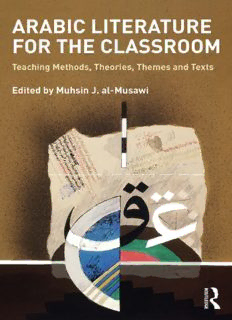
Arabic Literature for the Classroom: Teaching Methods, Theories, Themes and Texts PDF
Preview Arabic Literature for the Classroom: Teaching Methods, Theories, Themes and Texts
This rich volume with its useful and original focus on teaching makes me wish I were teaching Arabic literature again. Including chapters by experts on all the major and many minor genres, the highly stimulating collection will be fruitfully read by teachers and students of Arabic and world literature. Geert Jan van Gelder, Laudian Professor of Arabic emeritus, University of Oxford This critically acute and pedagogically canny collection offers a host of ways to bring Arabic literature more fully into comparative and world literature classrooms, as well as in more specifically Middle Eastern courses. These essays offer new pathways into a wide range of classic and modern texts, in illuminating discussions that will be full of interest for teachers, scholars, and general readers alike. David Damrosch, Ernest Bernbaum Professor and Chair, Department of Comparative Literature, Harvard University In this fine addition to a growing corpus of such materials, Muhsin al-Musawi and his colleagues have brought to bear on the teaching of Arabic literature a wide- ranging, high quality and apposite set of texts, insights, and best practices, designed to guide both novices and seasoned experts alike. Shawkat M. Toorawa, Professor of Arabic Literature, Yale University This page intentionally left blank ARABIC LITERATURE FOR THE CLASSROOM Arabic Literature for the Classroom argues for a more visible presence of Arabic within the humanities and social sciences, stressing the need to make Arabic literature available as a world literature, without damaging its own distinctive characteristics. The 19 chapters that make up this book broach theoretical and methodical cul- turalconcernsinteachingliteraturesfromnon-Americancultures,alongwithissues of cross-cultural communication, cultural competency and translation. While some chapters bring out the fascinating and ever tantalizing connections between Arabic and the literatures of medieval Europe, others employ specific approaches to teaching particular texts, potential methodologies, themes and a variety of topics that can place Arabic widely in a vast swath of academic application and learning. Topicsthatareexploredinclude gender,race, class,trauma,exile,dislocation,love, rape, humor, andcinema,aswellas issues that relate towritersand poets, women’s writing and the so-called nahd.ah (revival) movement in the nineteenth century. The comparative framework and multi-disciplinary approach mean that this book injects new life into the field of Arabic Literature. It will therefore be an essential resource for students, scholars and teachers of Arabic Literature, as well as for anyone with an interest in learning more about Arabic culture. Muhsin J. al-Musawi is Professor of Arabic and Comparative Literature at Columbia University and the author of many books in English and Arabic, including Arabic Poetry. His publications cover theory, postcolonial discourse, the Arabic novel, poetry, medieval Islamic knowledge and modern Arabic poetics. This page intentionally left blank ARABIC LITERATURE FOR THE CLASSROOM Teaching Methods, Theories, Themes and Texts Edited by Muhsin J. al-Musawi Firstpublished2017 byRoutledge 2ParkSquare,MiltonPark,Abingdon,OxonOX144RN andbyRoutledge 711ThirdAvenue,NewYork,NY10017 RoutledgeisanimprintoftheTaylor&FrancisGroup,aninformabusiness ©2017MuhsinJ.al-Musawi Therightoftheeditortobeidentifiedastheauthoroftheeditorialmaterial,and oftheauthorsfortheirindividualchapters,hasbeenassertedinaccordancewith sections77and78oftheCopyright,DesignsandPatentsAct1988. Allrightsreserved.Nopartofthisbookmaybereprintedorreproducedor utilisedinanyformorbyanyelectronic,mechanical,orothermeans,now knownorhereafterinvented,includingphotocopyingandrecording,orinany informationstorageorretrievalsystem,withoutpermissioninwritingfromthe publishers. Trademarknotice:Productorcorporatenamesmaybetrademarksorregistered trademarks,andareusedonlyforidentificationandexplanationwithoutintentto infringe. Everyefforthasbeenmadetocontactcopyrightholdersfortheirpermissionto reprintmaterialinthisbook.Thepublisherswouldbegratefultohearfromany copyrightholderwhoisnothereacknowledgedandwillundertaketorectifyany errorsoromissionsinfutureeditionsofthisbook BritishLibraryCataloguinginPublicationData AcataloguerecordforthisbookisavailablefromtheBritishLibrary LibraryofCongressCataloginginPublicationData Names:al-Musawi,MuhsinJ.,editor. Title:Arabicliteraturefortheclassroom:teachingmethods,theories,themesand texts/editedbyMuhsinJ.al-Musawi. Description:Abingdon,Oxon;NewYork,NY:Routledge,2017.|Includes bibliographicalreferencesandindex. Identifiers:LCCN2016049451|ISBN9781138211964(hardback)|ISBN 9781138211971(pbk.)|ISBN9781315451657(ebook) Subjects:LCSH:Arabicliterature–Studyandteaching. Classification:LCCPJ7505.A732017|DDC892.7/071–dc23 LCrecordavailableathttps://lccn.loc.gov/2016049451 ISBN:978-1-138-21196-4(hbk) ISBN:978-1-138-21197-1(pbk) ISBN:978-1-315-45165-7(ebk) TypesetinBembo byTaylor&FrancisBooks CONTENTS List of figures x List of contributors xi Acknowledgements xv Introduction: Arabic Literature for the Classroom: Teaching Methods, Theories, Themes and Texts xvi PARTI Theory and method 1 1 Proxidistant reading: Toward a critical pedagogy of the nahd.ah in US comparative literary studies 3 Shaden M. Tageldin 2 Teaching Arab women’s letters 24 Boutheina Khaldi 3 Arab women writers 1980–2010 40 miriam cooke 4 Teaching francophone Algerian women’s literature in a bilingual French-English context: Creative voices, dissident texts 54 Brinda J. Mehta 5 Approaches to teaching classical Arabic literature in English translation 72 Jocelyn Sharlet viii Contents 6 Classical and medieval Arabic literary delights: Towards teaching the humanistic literature of the Arabs 83 Nizar F. Hermes 7 Language through literature 96 Taoufik Ben Amor PARTII Theme 107 8 Lessons from the Maghreb 109 Hoda El Shakry 9 Teaching humor in Arabic literature and film 130 Tarek El-Ariss 10 The art of teaching Arab traumas triumphantly 145 Hanadi Al-Samman 11 The urban gateway: Teaching the city in modern Arabic literature 156 Ghenwa Hayek 12 Teaching Mahmoud Darwish 171 Jeffrey Sacks 13 Teaching the modernist Arabic poem in translation 189 Muhsin al-Musawi 14 The politics of perception in post-revolutionary Egyptian cinema 210 Nathaniel Greenberg PARTIII Text 223 15 Teaching the maqâmât in translation 225 Roger Allen 16 Ibn Hazm: Friendship, love and the quest for justice 237 Terri DeYoung 17 The Story of Zahra and its critics: Feminism and agency at war 254 Elizabeth M. Holt 18 The Arabic frametale and two European offspring 265 James T. Monroe Contents ix 19 Teaching the Arabian Nights 287 Muhsin al-Musawi Afterword: Teaching Arabic literature, Columbia University, May 2010 312 Jaroslav Stetkevych Index 315
Description: